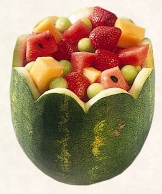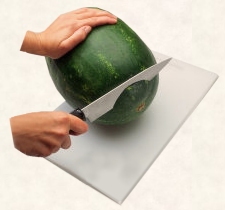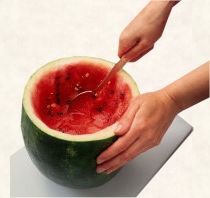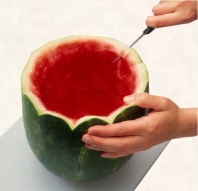|
Charis Cuisine
Wonders of Watermelon
Watermelon is not only
delicious, but extremely healthy, as well.
Discover how to make a Watermelon Bowl

Watermelon is about 90% water. The high zinc content in watermelon
makes it an excellent kidney and bladder cleanser. It helps to lower
blood pressure and, for you gentlemen, has been shown to promote
prostate health.
Watermelon has always been a good source of vitamins A and C, and
provides potassium and fiber. But now consumers have even more
reasons to enjoy a sweet fruit.
Scientists indicate that watermelon contains high levels of lycopene-an
antioxidant that may help the body fight cancer and prevent disease.
Found only in select fruits and vegetables, lycopene is very
effective at trapping cancer-promoting agents called free-oxygen
radicals.
A study conducted by Harvard University found that men who ate
lycopene-rich diets of tomatoes and tomato products had a much lower
risk of developing certain cancers, especially prostrate cancer. Lycopene is found only in red watermelon varieties. In fact, it
gives watermelon its red color, thus, the redder the watermelon, the
more lycopene it contains.

We have always known that watermelon offers a number of benefits.
Lycopene continues to emerge as a possible important,
effective agent in disease prevention. In addition to lycopene,
watermelon offers a host of other health benefits. It is fat-free,
yet delivers 100 percent on the critical energy component found in
functional foods.
In fact, most melons are rich in potassium, a nutrient that may help
control blood pressure, regulate heart beat, and possibly prevent
strokes. The 2005 Dietary Guidelines state that a potassium-rich
diet helps keep salt from raising blood pressure and may also reduce
the risk of developing kidney stones and possibly age-related bone
loss. The guidelines encourage adults to consume 4,700 milligrams
per day (while keeping sodium to less than 2,300 milligrams per day,
which is one teaspoon of salt).
Melons are also abundant in vitamin C, one arm of the now-famous
disease-fighting antioxidant trio. Another arm that's well
represented is beta-carotene.
Researchers believe that beta-carotene and vitamin C are capable of
preventing heart disease, cancer, and other chronic conditions. No
matter which way you cut them, when it comes to nutrition, melons
are number one.
Watermelon is a valuable source of lycopene, one of the carotenoids
that have actually been studied in humans. Research indicates that lycopene is helpful in reducing the risk of prostate, breast, and
endometrial cancers, as well as lung and colon cancer.
Whether you choose watermelons for their health benefits or simply
for their good flavor, they can be an excellent snack, summer dish
-- or gardening project.
|
Nutrients |
Units
|
Nutrient content per 100 grams
|
| Water
|
g
|
91.45
|
| Energy |
kcal
|
30
|
| Energy |
kj
|
127
|
|
Protein |
g
|
0.61
|
| Total lipid (fat)
|
g
|
0.15
|
| Ash
|
g
|
0.25
|
| Carbohydrate, by difference
|
g
|
7.55
|
|
Fiber, total dietary |
g
|
0.4
|
| Sugars, total
|
g
|
6.20
|
| Sucrose
|
g
|
1.21
|
| Glucose (dextrose)
|
g
|
1.58
|
| Fructose
|
g
|
3.36
|
| Lactose
|
g
|
0.00
|
| Maltose
|
g
|
0.06
|
| Galactose
|
g
|
0.00
|
| Starch
|
g
|
0.00
|
| Minerals
|
| Calcium, Ca
|
mg
|
7
|
| Iron, Fe
|
mg
|
0.24
|
| Magnesium, Mg
|
mg
|
10
|
| Phosphorus, P
|
mg
|
11
|
| Potassium, K
|
mg
|
112
|
| Sodium, Na
|
mg
|
1
|
| Zinc, Zn
|
mg
|
0.10
|
| Copper, Cu
|
mg
|
0.042
|
| Manganese, Mn
|
mg
|
0.038
|
| Fluoride, F
|
mcg
|
1.5
|
| Selenium, Se
|
mcg
|
0.4
|
| Vitamins
|
|
Vitamin
C, total ascorbic
acid |
mg
|
8.1
|
| Thiamin
|
mg
|
0.033
|
| Riboflavin
|
mg
|
0.021
|
| Niacin
|
mg
|
0.178
|
| Pantothenic acid
|
mg
|
0.221
|
| Vitamin B-6
|
mg
|
0.045
|
| Folate, total
|
mcg
|
3
|
| Folate, food
|
mcg
|
3
|
| Folate, DFE
|
mcg_DFE
|
3
|
| Choline, total
|
mg
|
4.1
|
| Betaine
|
mg
|
0.3
|
| Vitamin A, IU
|
IU
|
569
|
| Vitamin A, RAE
|
mcg_RAE
|
28
|
|
Vitamin E (alpha-tocopherol)
|
mg
|
0.05
|
| Vitamin K (phylloquinone)
|
mcg
|
0.1
|
| Lipids
|
| Fatty
acids, total saturated |
g
|
0.016
|
|
Fatty
acids, total monounsaturated |
g
|
0.037
|
| Fatty acids, total polyunsaturated
|
g
|
0.050
|
| Cholesterol
|
mg
|
0
|
| Phytosterols
|
mg
|
2
|
| Amino acids
|
| Tryptophan
|
g
|
0.007
|
| Threonine
|
g
|
0.027
|
| Isoleucine
|
g
|
0.019
|
| Leucine
|
g
|
0.018
|
| Lysine
|
g
|
0.062
|
| Methionine
|
g
|
0.006
|
| Cystine
|
g
|
0.002
|
| Phenylalanine
|
g
|
0.015
|
| Tyrosine
|
g
|
0.012
|
| Valine
|
g
|
0.016
|
|
Arginine |
g
|
0.059
|
| Histidine
|
g
|
0.006
|
| Alanine
|
g
|
0.017
|
| Aspartic acid
|
g
|
0.039
|
| Glutamic acid
|
g
|
0.063
|
| Glycine
|
g
|
0.010
|
| Proline
|
g
|
0.024
|
| Serine
|
g
|
0.016
|
| Other
|
| Carotene, beta
|
mcg
|
303
|
| Cryptoxanthin, beta
|
mcg
|
78
|
| Lycopene
|
mcg
|
4532
|
| Lutein + zeaxanthin
|
mcg
|
8
|
How To Make a Watermelon Bowl

To make a watermelon bowl garnish:
1. Place watermelon on its side on cutting board. Cut a thin piece
off bottom of melon with chef's knife to create flat surface.

2. Cut off top one-third of watermelon; reserve fruit for snacking.
3. Set watermelon upright on its flat surface. Remove pulp from
watermelon using long-handled spoon, leaving shell intact.

4. To scallop edge of watermelon bowl, place open end of drinking
glass against melon so top edge of glass is aligned with top edge of
bowl.
Draw a pencil line around glass edge to form scallop shape. Repeat
around entire edge of watermelon.

5. Carefully cut along pencil lines with utility knife to form
scalloped edge; fill bowl as desired.

6. Garnish.

Sources:
Watermelon nutritional facts source: USDA National Nutrient Database
for Standard Reference, Release 19 (2006)
Knowledge based Script
Dietary Fiber Food
Have a good recipe? Share it here!
|







